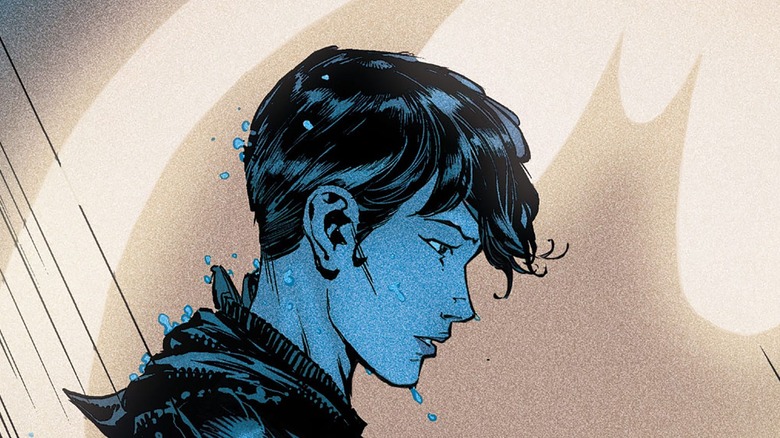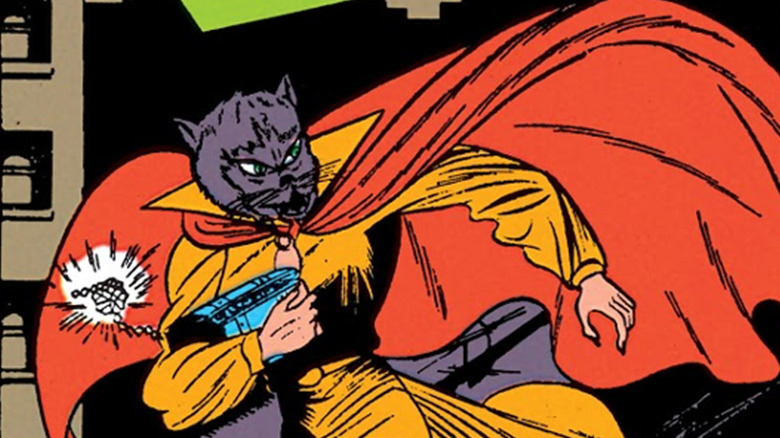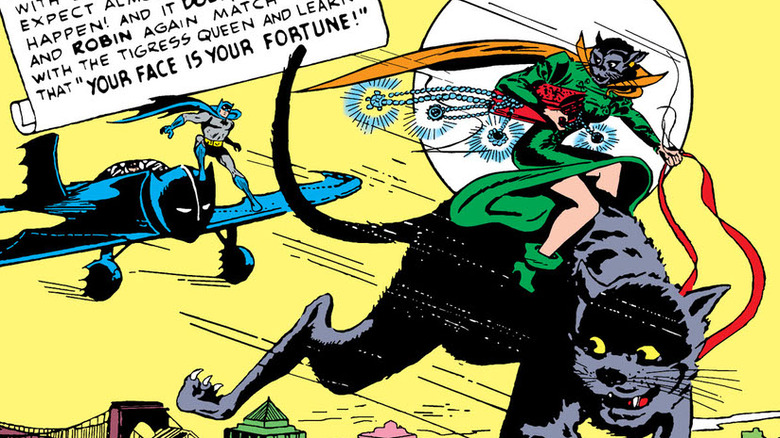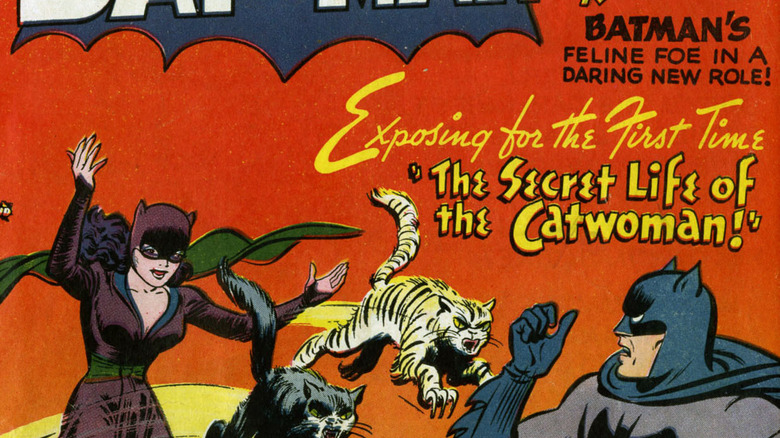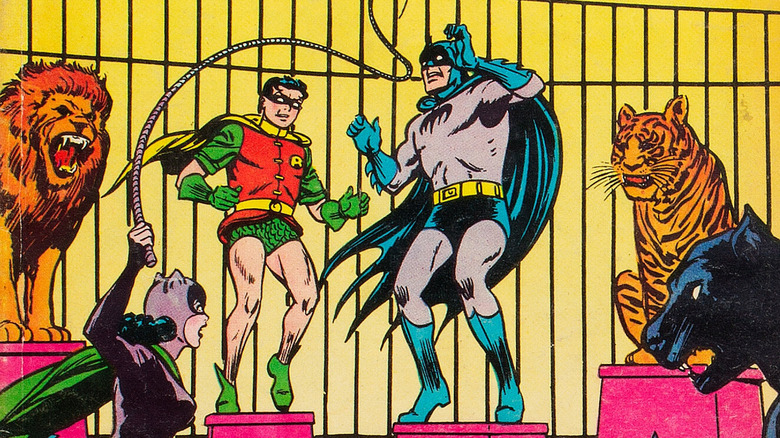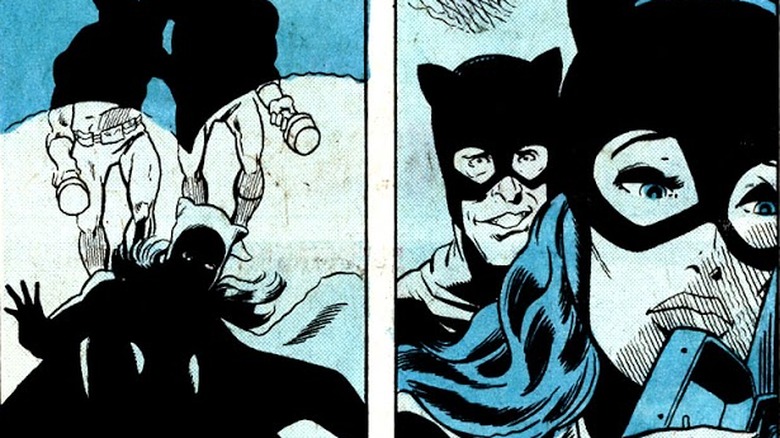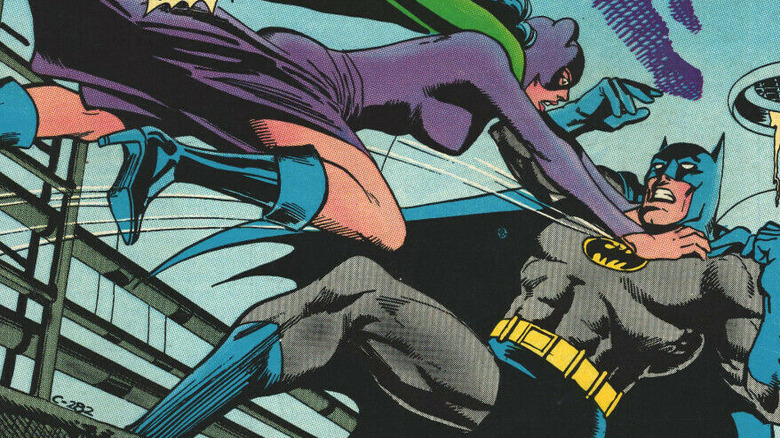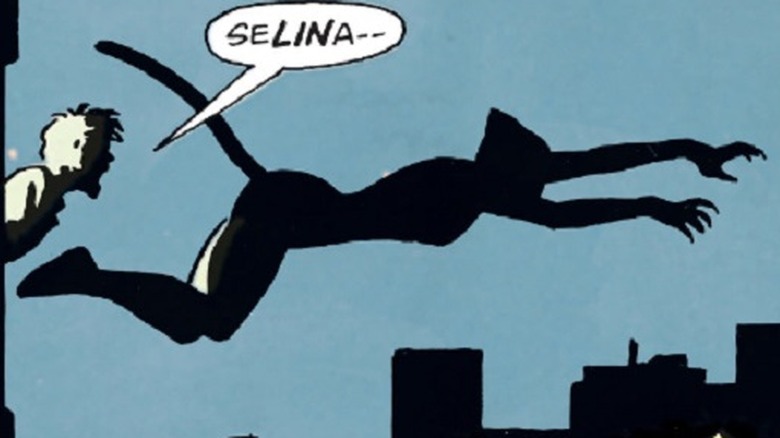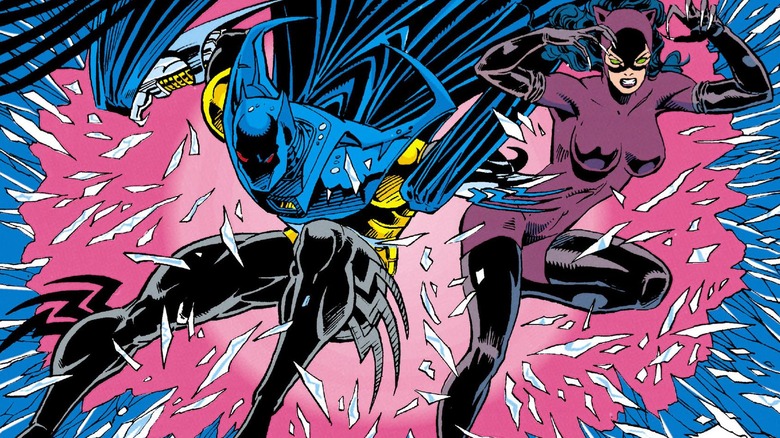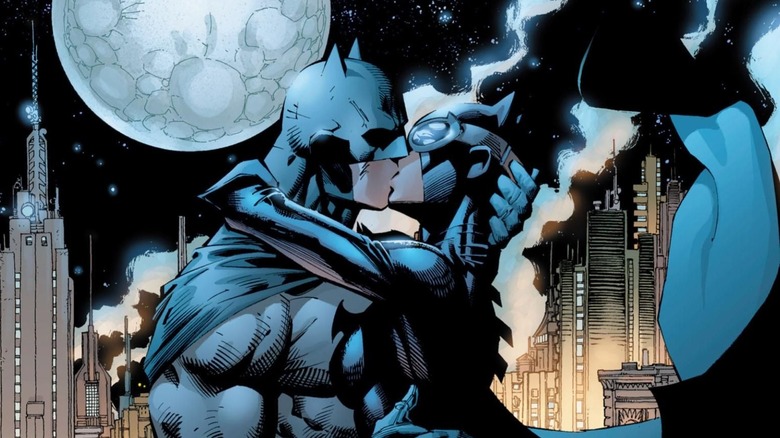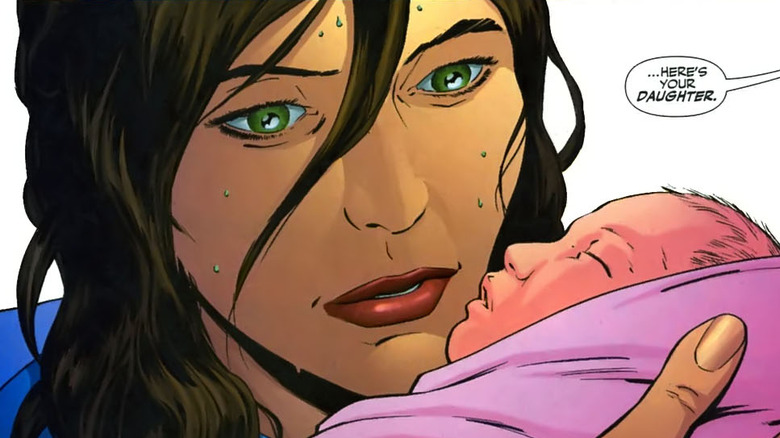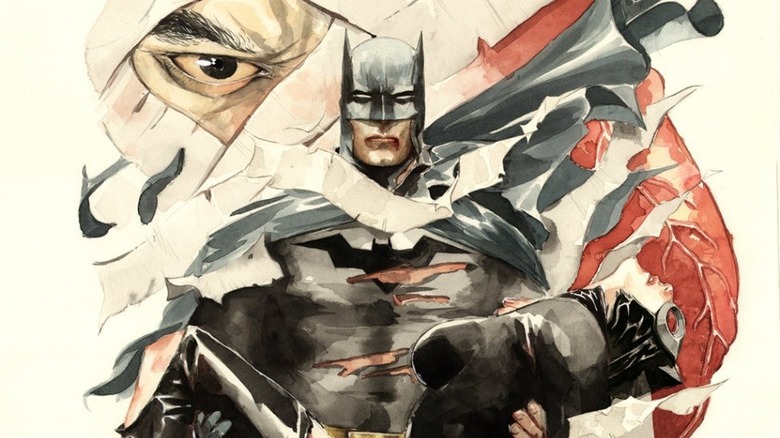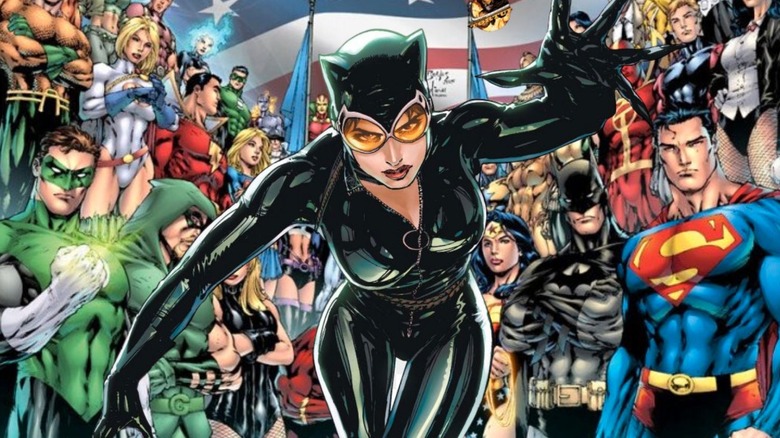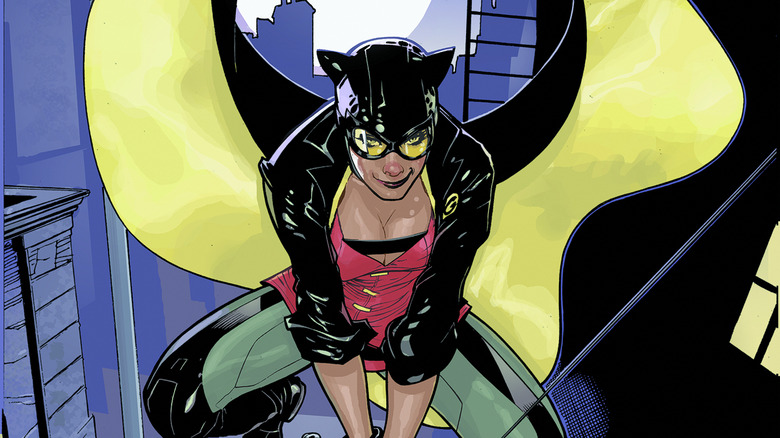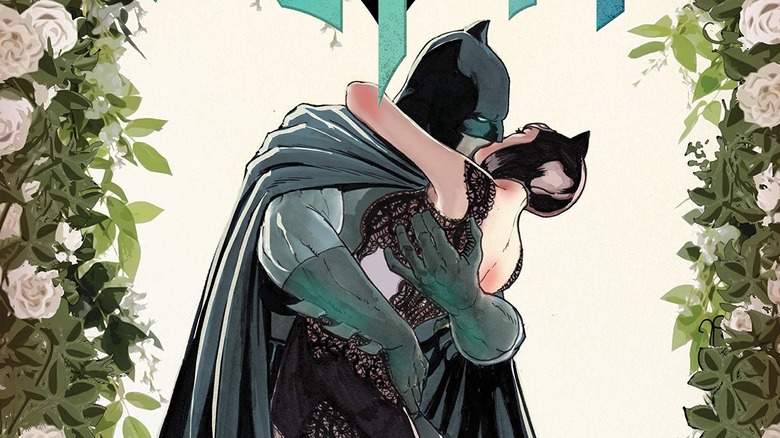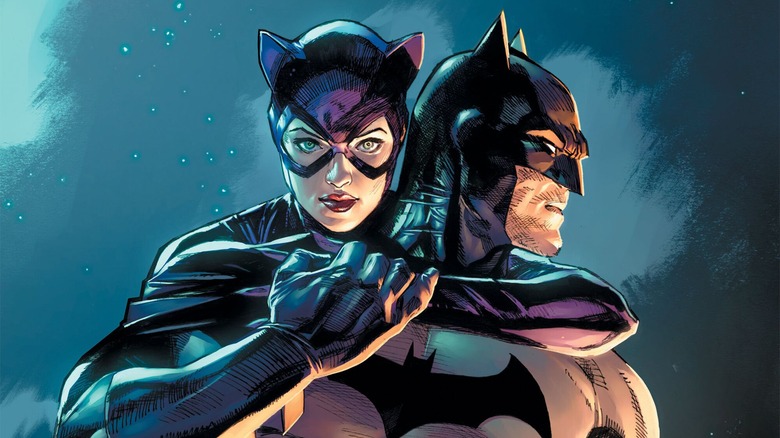Batman's History With Catwoman Explained
Catwoman has been a part of "Batman" stories since the beginning. Her first appearance was in "Batman" #1, shortly after the bat's own debut in "Detective Comics" a year earlier. From that first appearance, there's a clear romantic tension that only grows over the following decades. There are so many stories about the two, across a number of universes in the multiverse and DC reboot continuities, that it's nearly impossible to discuss every moment the two have spent together in the now more than 80 years they've shared the page.
But in the lead-up to "The Batman," which undoubtedly will draw on their significant history and may well follow in other cinematic iterations of Batman by bringing the cat and the bat together romantically, we thought we'd take a look at their most important moments together. Whether they be canonical stories or stories from alternate timelines, Batman and Catwoman have a long history full of sexual tension, mutual distrust, soapy melodrama, teamwork, and even some children.
First appearance of The Cat in Batman #1 (1940) & then "The Cat-Woman" in Batman #3 (1940)
Upon her first-ever appearance, the woman who would become Catwoman did not wear a costume and was not called "Catwoman," nor was she named "Selina Kyle" (or anything at all, for that matter). She was simply "The Cat." In fact, she wasn't even the main antagonist of the story, only appearing in the final few pages.
The story focuses on a valuable necklace belonging to a wealthy woman throwing a party on a yacht that's attended by a number of relatives who rely on her for money. These dependents are interested in stealing the necklace. Robin has been sent to keep an eye on the jewels and soon discovers a note from "The Cat" to one of the greedy nephews, who just so happens to have an elderly guest with him at the party.
There's an attack by some mobsters and Batman wins a costume contest (these being the early days of comics, of course). Finally, the dynamic duo catches the thief, who turns out to be a beautiful woman disguised as the nephew's guest. Batman decides they'll take her to the police, but "accidentally" loses her on the way back to shore, leading Robin to think Batman has a crush.
In the next issue, the idea is introduced that this charming thief may not be all bad. It's made clear that when it comes to Batman and Joker, the Cat-Woman is on Batman's side. She gives Batman and Robin information on the Joker and later makes a deal with the Joker to save Robin's life. The first use of the name "Catwoman" (or rather "Cat-Woman") appears an issue later and also introduces her original costume, one that's very different from what we've grown accustomed to over the years.
First signs of romance in Batman #15 (1943)
It doesn't take long for Batman and Catwoman to become romantically involved. In "Batman" #15, Bruce Wayne is one of the judges at a beauty contest for salon workers and recognizes Catwoman as Elva Barr, one of the employees in the contest. When he announces Elva as the winner of the contest, he and Catwoman have a short chat and she immediately begins to fall for him.
But Batman and Robin aren't sure exactly what's going on with the Catwoman, who seems to have gone straight. They decide to keep an eye on her. They discover that she is using her job at the salon to make masks of the wealthy patrons so that she can impersonate them and steal their jewels. But when next they meet, as Batman and Catwoman, Catwoman tells Batman to give her a chance, because she might have found salvation from a life of crime in a romance with Bruce Wayne (Bruce/Batman is a bit flustered by this revelation, to say the least). Bruce begins to court the lovely Ms. Barr, and in a matter of days, the two are engaged (it was a different time).
But when she announces to her gang that she's gone straight, one of them informs her that Wayne is sweet on another woman. Some hijinks ensue involving Catwoman acting as the other woman. It's revealed that Bruce was only courting Catwoman to get her to go straight. This leads Catwoman to throw herself more fully into her work as a thief and pull off a spree of jewel thefts across Gotham. The story ends with Batman and Robin apprehending her and placing her in jail, for now.
An unexpected identity and an unexpected ally in Batman #62 (1950) & #65 (1951)
In "Batman" #62, Batman chases Catwoman past a condemned building that collapses just as they are in range of its falling bricks. In a split second, Catwoman must decide whether she'll get away and let Batman die, or save his life at the risk of her own. She chooses the latter, but in the process takes a brick to the head and is knocked unconscious.
Batman brings her to the Batcave to recover. When she awakes, she's stunned to learn that she's a criminal with a feline alter ego, and that it's 1950. She reveals that her name is Selina Kyle and that she is a stewardess who was in a plane crash and hit her head (yes, 1950 "Batman" writers subscribed to the theory that if one head injury caused a problem, a second head injury would solve that problem). Batman theorizes that she has had amnesia and, in her amnesiac state, took up a life of crime as Catwoman. Selina is horrified by this news, but agrees to continue to play Catwoman so she can go undercover and help Batman, Robin, and Commissioner Gordon take down the deadly Mister X, with whom Catwoman had recently struck up a partnership.
The story ends with Selina saying she's through with Catwoman, but Batman thinks the police may need her again soon. Odd, then, that in the next story featuring Catwoman, issue #65's "Catwoman — Empress of the Underworld," Batman and Robin believe that Selina is back to her thieving ways as she leads a group of ne'er-do-wells on a crime spree, only to learn in the final moments that she's acting as an undercover agent for the Gotham police.
A return to crime, but a soft spot for Batman in Detective Comics #203 (1954)
After her recovery from amnesia and her days helping the Gotham police and Batman, Selina Kyle begins a more normal life owning and operating a pet shop. Meanwhile, Batman cleans up the streets of Gotham so well that the newspapers have nothing new to report. So an editor decides to run stories of Batman's most daring achievements, starting with his "Conquest of the Catwoman."
Somewhat surprisingly (though later clarified by comic book multiverse magic that will come up again here), Selina is enraged by this story, along with the taunts from old crooks about the story. She's soon visited by Batman, who apologizes for the story and assures Selina he had nothing to do with it, knowing that she wants to forget her past as Catwoman. But Selina's not so sure, and soon she's back at her old game with a new gang.
Despite her return to crime, she still has a soft spot for the caped crusader. When a member of her gang has Batman in his sights and wants to rid them of the do-gooder for good, Selina stops him, going so far as to say, "I couldn't bear to see him killed."
After her return to crime, Catwoman appears again as a villain in "Batman" #84 (in which she once again enters a beauty contest) and "Detective Comics" #211, both also in 1954. But she then disappears for 12 years and doesn't return in comics until 1966 in "Superman's Girlfriend Lois Lane" #70, of all places.
A child and a tragedy on alternate Earth in DC Super-Stars #17 (1977)
After returning in 1966, Catwoman made regular appearances as a villain across a number of DC titles. But the most exciting development came in "DC Super-Stars" #17, where readers learn that on Earth-Two, an alternate dimension in the multiverse, Selina reformed for good after she took a brick to the head that cured her amnesia in the 1950s. Shortly after reforming, she and Bruce married. And just a couple years later, they welcomed their daughter: Helena Wayne.
But things didn't stay idyllic forever. The story jumps forward to the 1970s, when a phone call interrupts a family evening. Selina answers and is pulled back into her life as Catwoman through the blackmail of an old criminal colleague. He pushes her to do one last job. She accepts to keep her family safe. Word of the robbery reaches the police, and Commissioner Gordon calls on Batman to put a stop to it.
Batman arrives on the scene. One of the thugs aims at the caped crusader, who kicks the man's arm to deflect the bullet. It catches an unintended mark: Selina. Bruce didn't know that she had been forced into participating in the crime. He thought the woman in the suit was a copycat (pun intended). Just as the bullet hits her, Selina lets out a cry of "Bruce!" and, in her last words, tells Bruce that she only did it for him.
In the aftermath of his beloved wife's death, Bruce burns his cape and cowl, giving up crime-fighting for good. But while her father is too heartbroken to seek vengeance, Helena Wayne is incited to find her mother's killers and bring them to justice. A mysterious figure with a Batman-like silhouette soon begins to stalk the streets of Gotham, and voila: Huntress is born.
An on-again, off-again romance from Batman #313 (1979)
In the last year of the '70s, Bruce Wayne takes Selina Kyle (once again reformed from her life of crime) out on a date that begins a years-long romance. It's telling that even on this first date in "Batman" #313, Bruce knows that becoming romantically involved with someone as smart as Selina may put his secret identity at risk. This concern is only amplified when Selina reveals she partially took to a life of crime to get Batman's attention and that, for a time, she thought she loved him.
Through the next few years of "Batman" stories, their relationship has its highs and lows as they work together as Batman and Catwoman in crime-fighting while also dating as Bruce and Selina. Like any serialized story form that involves romance, it's impossible not to compare some of the storylines to soap operas.
Early in their relationship, Bruce has her surveilled by Lucius Fox to ensure he can trust her and that she really is on the straight and narrow. When Selina learns of this, she is deeply hurt and nearly ends their relationship. Through the years, the relationship ends and begins again a number of times. During some of these "off again" eras, Bruce becomes involved with Vicki Vale and Talia al Ghul.
There's never a specific moment when Bruce reveals his identity to Selina. But in "Batman" #355, which tells the story of a brokenhearted Catwoman attacking Batman for the (romantic) pain he's caused her by becoming involved with Vicki Vale, Selina calls Batman "Bruce." It's an interesting choice by the writers and one that illuminates some of the drama of the previous years between the two, while also deepening their relationship in a single word/name.
A reinvention in Year One (1987) & Her Sister's Keeper (1989)
After the reality-altering and dimension-melding events of "Crisis on Infinite Earths" (which we do not have nearly enough time or space to cover here), DC commissioned Frank Miller, who was riding high off the success of "The Dark Knight Returns," to reimagine Bruce's first year as Batman. The result was "Year One."
"Year One" follows Bruce, Gordon, and Selina in the first year of Batman's activity in Gotham. Selina, a sex worker with an abusive pimp (we are very far beyond the clean-nosed comics of the '40s and '50s now), has two significant run-ins with Bruce/Batman during the story. First, the two get into a scuffle before either of them has taken up an animal mantle, because Bruce is naively trying to clean up the streets without much knowledge. Later, Selina meets Batman while robbing a crime boss that Batman is looking to bring down. But perhaps the most important aspect of "Year One" for Batman and Catwoman's history is that Batman inspires Selina to don the catsuit. In doing so, she begins seeking a better life for herself and her friend Holly by stealing from the wealthy.
Two years later, Mindy Newell penned the first-ever Catwoman miniseries "Her Sister's Keeper," which overlaps with Year One and further fleshes out Selina's story in that time. Again, there are two noteworthy interactions between the pair. In the first, Batman shows up during Catwoman's fight with her old pimp, who has kidnapped her sister Maggie (whose disappearance Batman is investigating), just in time to save Maggie from a fatal fall. In the final pages of the story, the two discuss the efficacy of the law when it comes to police violence against women (again, these aren't kid stories anymore). Catwoman lays a kiss on Batman, then hits him and claws his chest. She marks him as just a "smarter, cooler, more seductive" cop, and Selina "don't do cops."
A different Batman & two Batmen in "Knightfall" (1994)
In 1993, Catwoman got her first ongoing solo comic, but she still lived in Gotham and still had run-ins with the dark knight. Her solo run began just after Bane broke Bruce Wayne's back and consolidated all criminal activity in the city under his control, including Catwoman's thefts. But it didn't take long for her story to intersect (and, yes, crossover) with the "Batman: Knightfall" plot line, in which a new Batman fills in for Bruce Wayne.
Jean-Paul Valley, formerly the vigilante Azrael, takes over the mantle of the Bat when Bruce is no longer able. But Valley quickly changes not only the Batman costume, but also the methods and morality that Bruce had established. It's these changes that allow Catwoman to recognize that this isn't the original Batman—he's a meaner, more vicious version who's quicker to jump to conclusions and attack before investigating.
Although you'd think more people would recognize the obvious change in Batman, Catwoman is one of the few to notice. Others assume the Bat is just changing his tactics to be tougher on crime in the city. This highlights that even before they become close, Selina has a sense of who Batman really is; if not in terms of his secret identity, then at least in his core morality.
In their first encounter, Valley's Batman believes that Catwoman has stolen deadly chemicals for a nefarious purpose. She reveals to him that she stole them to keep them from being used. The two work together to bring down actual villains, but this is just an alliance of convenience for them both.
Their second encounter takes place just as the Knightfall saga comes to a head. Selina is in the middle of a job when she's interrupted by Valley's Batman. Their fight is then interrupted by the reappearance of Bruce's Batman. In the ensuing chaos, Catwoman helps Bruce take down the imposter.
Intermittent lovers and allies in the '90s & early 2000s
It took much less time after the continuity reboot in "Crisis on Infinite Earths" for Batman and Catwoman to become involved than the nearly 40 years it took before they began canonically dating in 1979. In "The Long Halloween," which began less than a decade after "Year One" in 1996 and is set not even a year later, the two begin a romantic relationship as Selina and Bruce. That doesn't stop Catwoman from flirting (rather aggressively, as is her style) with Batman.
Later in that story, Bruce is placed under one of Poison Ivy's powerful spells. Catwoman fights off Ivy for her new lover. It's a bit funny, then, that years later, after some more on-again/off-again between Bruce and Selina, Catwoman is manipulated by Ivy in "Hush" (also by "The Long Halloween" scribe Jeph Loeb). While Batman doesn't save Catwoman from Ivy herself in "Hush," he does show up just in time to help her fight Killer Croc, who Ivy has also manipulated. After their escape, the two kiss as Catwoman and Batman.
Catwoman then teams up with Batman to unravel the mystery of "Hush," while Bruce and Selina see each other socially. As Catwoman and Batman work together more, and as their romantic relationship grows, Bruce decides that he needs to tell Selina the truth about his identity. That decision brings them closer together, but doesn't ensure their relationship; at the end of the story, Bruce decides to end it (for now) because he cannot trust whether his mind has been manipulated by Ivy or Scarecrow.
Another child in One Year Later
One year after the events of "Infinite Crisis" (a huge, dimension-spanning event that served as a sequel to "Crisis on Infinite Earths"), we learn that Selina has given up not just her Catwoman identity, but also her identity as Selina. She has taken on the name Irena Dubrovna (a reference to the 1942 classic horror film "Cat People") so that she can live safely, because she has become a mother.
In this version, Helena Kyle is not the child of Bruce Wayne, but instead the offspring of a one-night stand that Selina had with Smart Bomb, aka Sam Bradley. Even though Bruce isn't Helena's father, he shows great affection for the child and helps Selina care for her, offering monetary and emotional support to the single mother.
But as on Earth-Two, Selina can't give up Catwoman for good and her alias is discovered. In the following stories, Catwoman and Batman have a romantic and "professional" relationship, all while also caring for Helena. But Selina's life is dangerous and full of violence, so eventually she decides she needs to give up her child. Bruce helps get Helena adopted.
Batman saves Catwoman's heart (literally) in Heart of Hush
We've all heard of "getting your heart stolen," but "Heart of Hush" makes that concept concrete, albeit in a way that's counter to the generally positive meaning the idiom has. Hush returns to Gotham, having heard that an organization called "The Black Glove" is beginning a plan to kill Batman. Hush believes that Batman's death must belong to him.
Hush knows how much Selina means to Batman, so he attacks her and surgically removes her heart. He connects her to cardiopulmonary machines so that she can survive without it, but the trap for Batman has been set. Batman tracks Hush down and asks why he attacked Selina. Hush responds that no matter who Batman is with (at this time, Bruce is dating model and activist Jezebel Jet), "there has only been one woman that really held your heart and now I'm holding hers."
It's a moment of insight from the villain, and one that Bruce later confirms. After literally saving her heart from Hush, Bruce speaks to a Selina he believes to be unconscious post-operation. He admits that Hush "was right" and softly kisses her on the forehead while telling her, "I will always love you."
Catwoman and the Justice League
As an ally of Batman, Catwoman has also often been an ally of the Justice League that Batman belongs to. While she has never been considered a part of that team herself, she has been part of a different league.
The first major moment for Selina and the Justice League came in the 1990s, when she saved the Justice League from Prometheus, who had defeated most of the super team. (Killjoy Batman still tells her to return some stolen items even after she's saved the group). She works with Batman and the rest of the League to bring down the "Secret Society of Super Villains" to which she used to belong in "Crisis of Conscience" in 2005. She again helps Batman and the League against the Secret Society in the massive, dimension-spanning "Forever Evil" storyline in the early 2010s.
Also, at the start of the New 52 continuity in the early 2010s, she is recruited to the Justice League of America, which is different from the Justice League. Founded by Amanda Waller, this Justice League of America was created to serve America's interests and exists explicitly as a contingency in case the Justice League goes rogue. Selina is brought in as someone who knows Bruce well and could be an asset in this scenario.
Catbird, Batman's sidekick in Gothtopia
During the New 52 story "Gothtopia," Scarecrow has created a "contentment sedative," which he pumps into Gotham. This spreads a widespread delusion of an almost crimeless utopia that's protected by costumed heroes, including Batman and his partner Catbird, aka Selina Kyle. But they're not just partners, as we learn early on in the story. Poison Ivy attempts to kiss Batman, but Catbird tells her "that job is taken;" he and Catbird are also a couple.
As the story goes on, the delusion begins to slip and characters begin to wonder whether the world is actually this perfect. Batman becomes convinced that Ivy, who was ranting about the world being a lie, was right. When he tells this to Selina, she attacks him and tells him he's dangerous to himself and to Gotham because she does not want her perfect reality challenged.
Of course, Selina's reality doesn't go unchallenged. She has a dream, spurred by the appearance of a catsuit, in which Catbird and Catwoman fight. They each argue that the other's reality is fake. Catbird argues that she is happy and that Batman loves her. Catwoman retorts, "Batman wanted to change us. That's not love." It's a moment in an otherwise wild story that speaks to a real concern of Selina's in all of her relationships with Bruce.
And the story's epilogue only hurts more as Selina, now Catwoman again, talks to Batman about their happiness as a couple in Gothtopia. He tells her it wasn't real, that it was just what she wanted to see. When she asks if he saw the same thing, he lies and says all he saw was a safe Gotham.
A wedding, a runaway bride, and a reunion in Rebirth
In "Rebirth" (yet another continuity reset — what can we say, DC really loves them), Batman works to prove Selina's innocence in the deaths of over 200 people, a rap that she takes for her friend Holly. As he works to prove her innocence, the two grow closer and eventually begin a romantic relationship. At one point, they discuss whether they first met on a boat when she impersonated an old woman (as happened in "Batman" #1 in 1940) or on the streets when Bruce tried to help Holly (as happened in "Year One"). It's a nice nod to their long history.
Shortly after they become involved, Batman reveals to Catwoman that after getting the first diamond she ever stole back from her, he bought it, knowing he would need it. He says he's known from the beginning that it would be her. He asks her to marry him, and she says yes.
But on the day of the wedding, her friend Holly instills doubt in Selina. Holly asks if Bruce can be happy or if he needs his misery to be Batman. It's enough to make Selina abandon the wedding and leave for the West Coast.
It's revealed that this was Bane's ploy, seeking (as usual) to break Bruce/Batman of his will to live and act as Batman. Selina finds her way back to Batman, but first, they spend time in Paris, allowing Bruce to recover from a defeat at the hands of Bane. She nurses him back to health before they return to Gotham and take Bane down together. And after they've beaten Bane, they decide to get married again. When they miss going to a judge in the middle of the night, Selina says "I don't need a judge. Or a dress. Or an audience. To know that you ... you and I ... The Bat and The Cat. We are Forever."
A romance for the ages in Batman/Catwoman
The currently running "Batman/Catwoman" series, written by Tom King (who also wrote their romance in the above "Rebirth" storyline), really emphasizes this "forever." It follows three different timelines: the past, the present, and the future.
The past shows Selina's difficulties acting as both a villain, sometimes even working along with the Joker, and Batman's lover, especially when he's too smart to ignore her connections to the underworld. The present follows Batman and Catwoman as they work together to stop a spree of murders by the Phantasm while also fully embracing their love for one another. And the future depicts Selina in the days after Bruce's death from illness (at least that's what we're told), visiting an old friend and reminiscing.
It's not clear exactly where the stories will go, but the exploration of three different timelines allows for a beautifully full picture of one of the greatest romances in comic books and arguably popular culture writ large: the bat and the cat.
